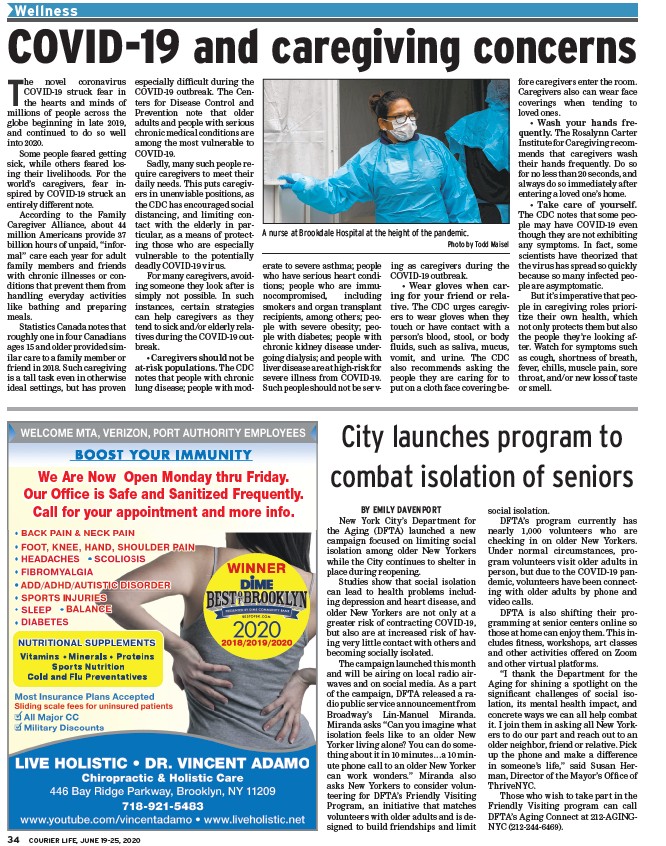
COVID-19 and caregiving concerns
The novel coronavirus
COVID-19 struck fear in
the hearts and minds of
millions of people across the
globe beginning in late 2019,
and continued to do so well
into 2020.
Some people feared getting
sick, while others feared losing
their livelihoods. For the
world’s caregivers, fear inspired
by COVID-19 struck an
entirely different note.
According to the Family
Caregiver Alliance, about 44
million Americans provide 37
billion hours of unpaid, “informal”
care each year for adult
family members and friends
with chronic illnesses or conditions
that prevent them from
handling everyday activities
like bathing and preparing
meals.
Statistics Canada notes that
roughly one in four Canadians
ages 15 and older provided similar
care to a family member or
friend in 2018. Such caregiving
is a tall task even in otherwise
ideal settings, but has proven
especially diffi cult during the
COVID-19 outbreak. The Centers
COURIER L 34 IFE, JUNE 19-25, 2020
for Disease Control and
Prevention note that older
adults and people with serious
chronic medical conditions are
among the most vulnerable to
COVID-19.
Sadly, many such people require
caregivers to meet their
daily needs. This puts caregivers
in unenviable positions, as
the CDC has encouraged social
distancing, and limiting contact
with the elderly in particular,
as a means of protecting
those who are especially
vulnerable to the potentially
deadly COVID-19 virus.
For many caregivers, avoiding
someone they look after is
simply not possible. In such
instances, certain strategies
can help caregivers as they
tend to sick and/or elderly relatives
during the COVID-19 outbreak.
• Caregivers should not be
at-risk populations. The CDC
notes that people with chronic
lung disease; people with moderate
to severe asthma; people
who have serious heart conditions;
people who are immunocompromised,
including
smokers and organ transplant
recipients, among others; people
with severe obesity; people
with diabetes; people with
chronic kidney disease undergoing
dialysis; and people with
liver disease are at high-risk for
severe illness from COVID-19.
Such people should not be serving
as caregivers during the
COVID-19 outbreak.
• Wear gloves when caring
for your friend or relative.
The CDC urges caregivers
to wear gloves when they
touch or have contact with a
person’s blood, stool, or body
fl uids, such as saliva, mucus,
vomit, and urine. The CDC
also recommends asking the
people they are caring for to
put on a cloth face covering before
caregivers enter the room.
Caregivers also can wear face
coverings when tending to
loved ones.
• Wash your hands frequently.
The Rosalynn Carter
Institute for Caregiving recommends
that caregivers wash
their hands frequently. Do so
for no less than 20 seconds, and
always do so immediately after
entering a loved one’s home.
• Take care of yourself.
The CDC notes that some people
may have COVID-19 even
though they are not exhibiting
any symptoms. In fact, some
scientists have theorized that
the virus has spread so quickly
because so many infected people
are asymptomatic.
But it’s imperative that people
in caregiving roles prioritize
their own health, which
not only protects them but also
the people they’re looking after.
Watch for symptoms such
as cough, shortness of breath,
fever, chills, muscle pain, sore
throat, and/or new loss of taste
or smell.
A nurse at Brookdale Hospital at the height of the pandemic.
Photo by Todd Maisel
City launches program to
combat isolation of seniors
BY EMILY DAVENPORT
New York City’s Department for
the Aging (DFTA) launched a new
campaign focused on limiting social
isolation among older New Yorkers
while the City continues to shelter in
place during reopening.
Studies show that social isolation
can lead to health problems including
depression and heart disease, and
older New Yorkers are not only at a
greater risk of contracting COVID-19,
but also are at increased risk of having
very little contact with others and
becoming socially isolated.
The campaign launched this month
and will be airing on local radio airwaves
and on social media. As a part
of the campaign, DFTA released a radio
public service announcement from
Broadway’s Lin-Manuel Miranda.
Miranda asks “Can you imagine what
isolation feels like to an older New
Yorker living alone? You can do something
about it in 10 minutes…a 10 minute
phone call to an older New Yorker
can work wonders.” Miranda also
asks New Yorkers to consider volunteering
for DFTA’s Friendly Visiting
Program, an initiative that matches
volunteers with older adults and is designed
to build friendships and limit
social isolation.
DFTA’s program currently has
nearly 1,000 volunteers who are
checking in on older New Yorkers.
Under normal circumstances, program
volunteers visit older adults in
person, but due to the COVID-19 pandemic,
volunteers have been connecting
with older adults by phone and
video calls.
DFTA is also shifting their programming
at senior centers online so
those at home can enjoy them. This includes
fi tness, workshops, art classes
and other activities offered on Zoom
and other virtual platforms.
“I thank the Department for the
Aging for shining a spotlight on the
signifi cant challenges of social isolation,
its mental health impact, and
concrete ways we can all help combat
it. I join them in asking all New Yorkers
to do our part and reach out to an
older neighbor, friend or relative. Pick
up the phone and make a difference
in someone’s life,” said Susan Herman,
Director of the Mayor’s Offi ce of
ThriveNYC.
Those who wish to take part in the
Friendly Visiting program can call
DFTA’s Aging Connect at 212-AGINGNYC
(212-244-6469).
Wellness
We Are Now Open Monday thru Friday.
Our Office is Safe and Sanitized Frequently.
Call for your appointment and more info.